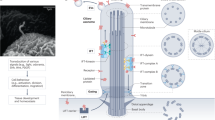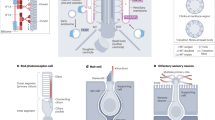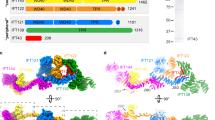Abstract
Using RNAi screening, proteomics, cell biological and mouse genetics approaches, we have identified a complex of nine proteins, seven of which are disrupted in human ciliopathies. A transmembrane component, TMEM231, localizes to the basal body before and independently of intraflagellar transport in a Septin 2 (Sept2)-regulated fashion. The localizations of TMEM231, B9D1 (B9 domain-containing protein 1) and CC2D2A (coiled-coil and C2 domain-containing protein 2A) at the transition zone are dependent on one another and on Sept2. Disruption of the complex in vitro causes a reduction in cilia formation and a loss of signalling receptors from the remaining cilia. Mouse knockouts of B9D1 and TMEM231 have identical defects in Sonic hedgehog (Shh) signalling and ciliogenesis. Strikingly, disruption of the complex increases the rate of diffusion into the ciliary membrane and the amount of plasma-membrane protein in the cilia. The complex that we have described is essential for normal cilia function and acts as a diffusion barrier to maintain the cilia membrane as a compartmentalized signalling organelle.
This is a preview of subscription content, access via your institution
Access options
Subscribe to this journal
Receive 12 print issues and online access
$209.00 per year
only $17.42 per issue
Buy this article
- Purchase on Springer Link
- Instant access to full article PDF
Prices may be subject to local taxes which are calculated during checkout








Similar content being viewed by others
References
Huangfu, D. et al. Hedgehog signalling in the mouse requires intraflagellar transport proteins. Nature 426, 83–87 (2003).
Rohatgi, R., Milenkovic, L. & Scott, M. P. Patched1 regulates hedgehog signaling at the primary cilium. Science 317, 372–376 (2007).
Tukachinsky, H., Lopez, L. V. & Salic, A. A mechanism for vertebrate Hedgehog signaling: recruitment to cilia and dissociation of SuFu–Gli protein complexes. J. Cell Biol. 191, 415–428 (2010).
Satir, P. & Christensen, S. T. Overview of structure and function of mammalian cilia. Annu. Rev. Physiol. 69, 377–400 (2007).
Davenport, J. R. & Yoder, B. K. An incredible decade for the primary cilium: a look at a once-forgotten organelle. Am. J. Physiol. Renal. Physiol. 289, F1159–F1169 (2005).
Pan, J., Wang, Q. & Snell, W. J. Cilium-generated signaling and cilia-related disorders. Lab. Invest. 85, 452–463 (2005).
Eley, L., Yates, L. M. & Goodship, J. A. Cilia and disease. Curr. Opin. Genet. Dev. 15, 308–314 (2005).
Hunnicutt, G. R., Kosfiszer, M. G. & Snell, W. J. Cell body and flagellar agglutinins in Chlamydomonas reinhardtii: the cell body plasma membrane is a reservoir for agglutinins whose migration to the flagella is regulated by a functional barrier. J. Cell Biol. 111, 1605–1616 (1990).
Vieira, O. V. et al. FAPP2, cilium formation, and compartmentalization of the apical membrane in polarized Madin–Darby canine kidney (MDCK) cells. Proc. Natl Acad. Sci. USA 103, 18556–18561 (2006).
Ringo, D. L. Flagellar motion and fine structure of the flagellar apparatus in Chlamydomonas. J. Cell Biol. 33, 543–571 (1967).
Gilula, N. B. & Satir, P. The ciliary necklace. A ciliary membrane specialization. J. Cell Biol. 53, 494–509 (1972).
Rohatgi, R. & Snell, W. J. The ciliary membrane. Curr. Opin. Cell Biol. 22, 541–546 (2010).
Craige, B. et al. CEP290 tethers flagellar transition zone microtubules to the membrane and regulates flagellar protein content. J. Cell Biol. 190, 927–940 (2010).
Williams, C. L. et al. MKS and NPHP modules cooperate to establish basal body/transition zone membrane associations and ciliary gate function during ciliogenesis. J. Cell Biol. 192, 1023–1041 (2011).
Hu, Q. et al. A septin diffusion barrier at the base of the primary cilium maintains ciliary membrane protein distribution. Science 329, 436–439 (2010).
Ashique, A. M. et al. The Rfx4 transcription factor modulates Shh signaling by regional control of ciliogenesis. Sci. Signal 2, ra70 (2009).
Torres, J. Z., Miller, J. J. & Jackson, P. K. High-throughput generation of tagged stable cell lines for proteomic analysis. Proteomics 9, 2888–2891 (2009).
Nachury, M. V. Tandem affinity purification of the BBSome, a critical regulator of Rab8 in ciliogenesis. Methods Enzymol. 439, 501–513 (2008).
Cardenas-Rodriguez, M. & Badano, J. L. Ciliary biology: understanding the cellular and genetic basis of human ciliopathies. Am. J. Med. Genet. C Semin. Med. Genet. 151C, 263–280 (2009).
Reiter, J. F. & Skarnes, W. C. Tectonic, a novel regulator of the Hedgehog pathway required for both activation and inhibition. Genes Dev. 20, 22–27 (2006).
Hopp, K. et al. B9D1 is revealed as a novel Meckel syndrome (MKS) gene by targeted exon-enriched next-generation sequencing and deletion analysis. Hum. Mol. Genet. 20, 2524–2534 (2011).
Dowdle, W. E. et al. Disruption of a ciliary B9 protein complex causes Meckel syndrome. Am. J. Hum. Genet. 89, 94–110 (2011).
Garcia-Gonzalo, F. R. et al. A transition zone complex regulates mammalian ciliogenesis and ciliary membrane composition. Nat. Genet. 43, 776–784 (2011).
Sang, L. et al. Mapping the NPHP–JBTS–MKS protein network reveals ciliopathy disease genes and pathways. Cell 145, 513–528 (2011).
Sorokin, S. P. Reconstructions of centriole formation and ciliogenesis in mammalian lungs. J. Cell Sci. 3, 207–230 (1968).
Pazour, G. J. et al. Chlamydomonas IFT88 and its mouse homologue, polycystic kidney disease gene tg737, are required for assembly of cilia and flagella. J. Cell Biol. 151, 709–718 (2000).
Francis, S. S., Sfakianos, J., Lo, B. & Mellman, I. A hierarchy of signals regulates entry of membrane proteins into the ciliary membrane domain in epithelial cells. J. Cell Biol. 193, 219–233 (2011).
Murcia, N. S. et al. The Oak Ridge Polycystic Kidney (orpk) disease gene is required for left-right axis determination. Development 127, 2347–2355 (2000).
Louie, C. M. et al. AHI1 is required for photoreceptor outer segment development and is a modifier for retinal degeneration in nephronophthisis. Nat. Genet. 42, 175–180 (2010).
Bachmann-Gagescu, R. et al. The ciliopathy gene cc2d2a controls zebrafish photoreceptor outer segment development through a role in Rab8-dependent vesicle trafficking. Hum. Mol. Genet. 20, 4041–4055 (2011).
Town, T. et al. The stumpy gene is required for mammalian ciliogenesis. Proc. Natl Acad. Sci. USA 105, 2853–2858 (2008).
Breunig, J. J. et al. Primary cilia regulate hippocampal neurogenesis by mediating sonic hedgehog signaling. Proc. Natl Acad. Sci. USA 105, 13127–13132 (2008).
Weatherbee, S. D., Niswander, L. A. & Anderson, K. V. A mouse model for Meckel syndrome reveals Mks1 is required for ciliogenesis and Hedgehog signaling. Hum. Mol. Genet. 18, 4565–4575 (2009).
Cui, C. et al. Disruption of Mks1 localization to the mother centriole causes cilia defects and developmental malformations in Meckel–Gruber syndrome. Dis. Model Mech. 4, 43–56 (2011).
Lancaster, M. A. et al. Impaired Wnt-beta-catenin signaling disrupts adult renal homeostasis and leads to cystic kidney ciliopathy. Nat. Med. 15, 1046–1054 (2009).
Williams, C. L., Winkelbauer, M. E., Schafer, J. C., Michaud, E. J. & Yoder, B. K. Functional redundancy of the B9 proteins and nephrocystins in Caenorhabditis elegans ciliogenesis. Mol. Biol. Cell 19, 2154–2168 (2008).
Bialas, N. J. et al. Functional interactions between the ciliopathy-associated Meckel syndrome 1 (MKS1) protein and two novel MKS1-related (MKSR) proteins. J. Cell Sci. 122, 611–624 (2009).
Williams, C. L., Masyukova, S. V. & Yoder, B. K. Normal ciliogenesis requires synergy between the cystic kidney disease genes MKS-3 and NPHP-4. J. Am. Soc. Nephrol. 21, 782–793 (2010).
Gorden, N. T. et al. CC2D2A is mutated in Joubert syndrome and interacts with the ciliopathy-associated basal body protein CEP290. Am. J. Hum. Genet. 83, 559–571 (2008).
Fliegauf, M. et al. Nephrocystin specifically localizes to the transition zone of renal and respiratory cilia and photoreceptor connecting cilia. J. Am. Soc. Nephrol. 17, 2424–2433 (2006).
Won, J. et al. NPHP4 is necessary for normal photoreceptor ribbon synapse maintenance and outer segment formation, and for sperm development. Hum. Mol. Genet. 20, 482–496 (2010).
Valente, E. M. et al. Mutations in TMEM216 perturb ciliogenesis and cause Joubert, Meckel and related syndromes. Nat. Genet. 42, 619–625 (2010).
Evangelista, M. et al. Kinome siRNA screen identifies regulators of ciliogenesis and hedgehog signal transduction. Sci. Signal 1, ra7 (2008).
Tang, T. et al. A mouse knockout library for secreted and transmembrane proteins. Nat. Biotechnol. 28, 749–755 (2010).
Acknowledgements
We thank M. Roose-Girma (Genentech) for generating B9D1-knockout mouse; J. Miller, S. Mukhopadhyay and P. Jackson (all Genentech) for various LAP tagging constructs and advice on tandem affinity purification technology; S. Francis (Genentech) for GFP–CEACAM1 and GFP–GPI retroviral particles; B. Bingol for help with ImageJ analysis; D. Grant, M. Solloway and H. Tian for help with histology; J. Ernst and H. Li for octyl-Shh; and the Genentech research community for their advice and assistance. TMEM231-knockout mice were produced in a collaboration between Genentech and Lexicon Pharmaceuticals (The Woodlands) to analyse the function of about 500 secreted and transmembrane proteins. Genentech provided financial support.
Author information
Authors and Affiliations
Contributions
B.C. planned, carried out and analysed experiments. P.L. and W.S. carried out mass spectrometry experiments. Y.C. and P.E.H. collected the gel filtration samples. C.C. and L.G.K acquiredthe super-resolution images. B.C. and A.S.P. designed and interpreted the experiments and wrotethe manuscript.
Corresponding author
Ethics declarations
Competing interests
All authors are employees of Genentech, a for-profit institution.
Supplementary information
Supplementary Information
Supplementary Information (PDF 550 kb)
Supplementary Movie 1
Supplementary Information (AVI 297 kb)
Supplementary Table 1
Supplementary Information (XLS 28 kb)
Supplementary Table 2
Supplementary Information (XLS 30 kb)
Rights and permissions
About this article
Cite this article
Chih, B., Liu, P., Chinn, Y. et al. A ciliopathy complex at the transition zone protects the cilia as a privileged membrane domain. Nat Cell Biol 14, 61–72 (2012). https://doi.org/10.1038/ncb2410
Received:
Accepted:
Published:
Issue Date:
DOI: https://doi.org/10.1038/ncb2410
This article is cited by
-
Transport and barrier mechanisms that regulate ciliary compartmentalization and ciliopathies
Nature Reviews Nephrology (2024)
-
Primary cilia as dynamic and diverse signalling hubs in development and disease
Nature Reviews Genetics (2023)
-
The tectonic complex regulates membrane protein composition in the photoreceptor cilium
Nature Communications (2023)
-
Ciliary transition zone proteins coordinate ciliary protein composition and ectosome shedding
Nature Communications (2022)
-
Three Novel Variants of CEP290 and CC2D2DA and a Link Between ZNF77 and SHH Signaling Pathway Are Found in Two Meckel-Gruber Syndrome Fetuses
Reproductive Sciences (2022)



